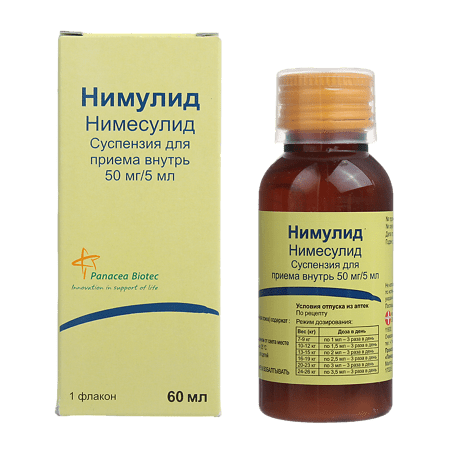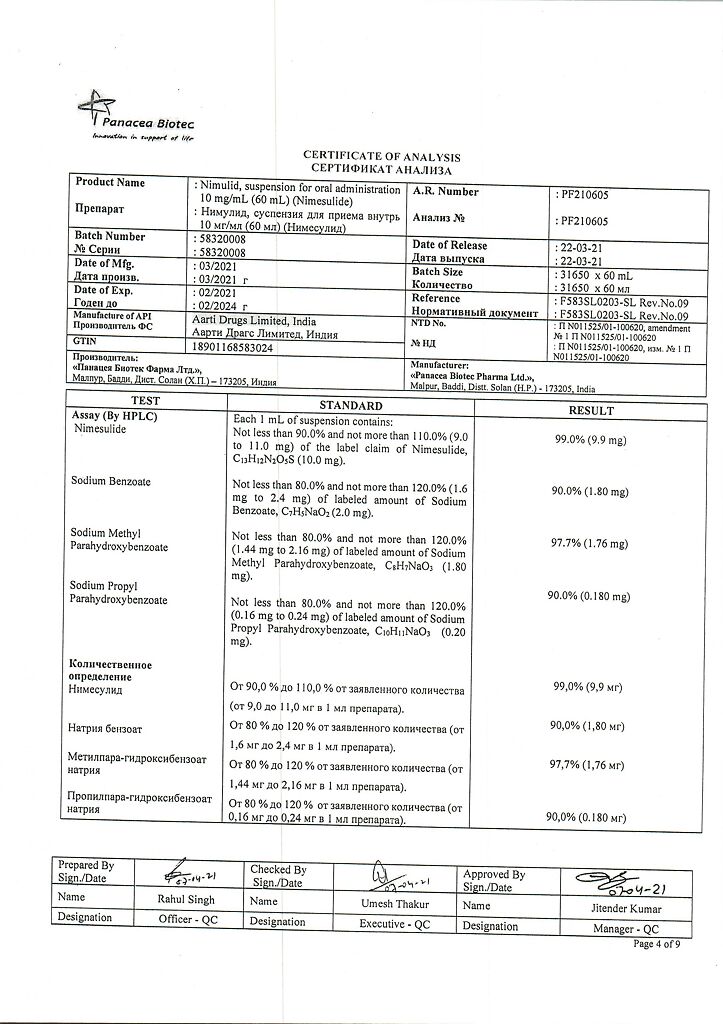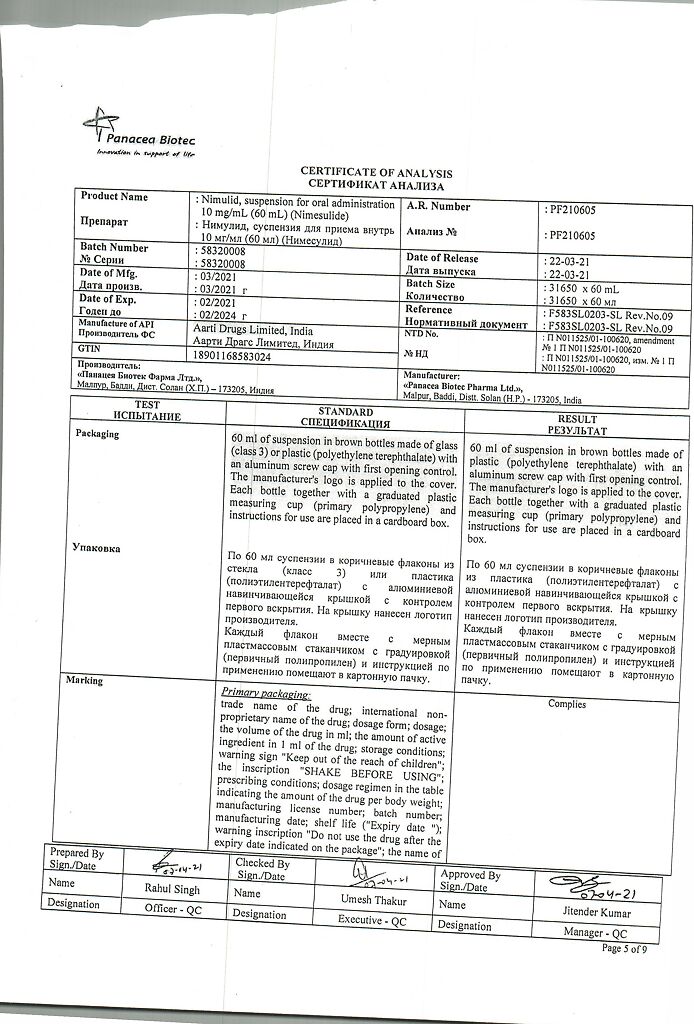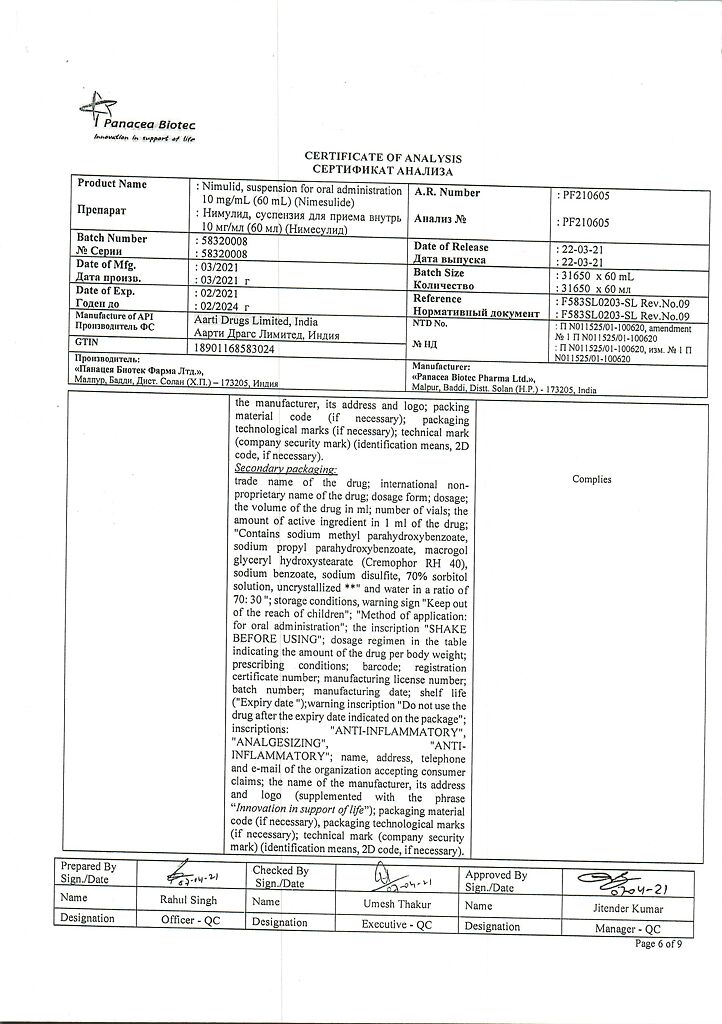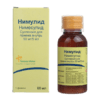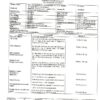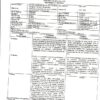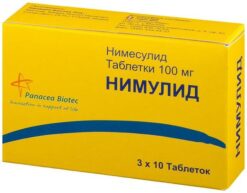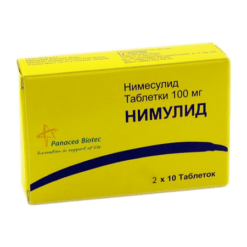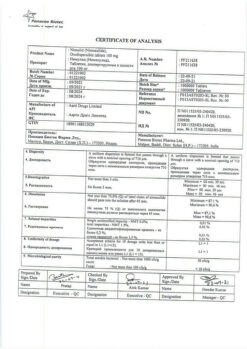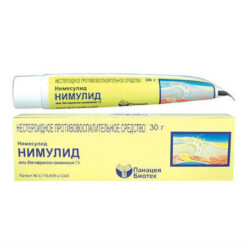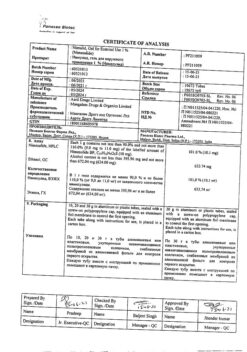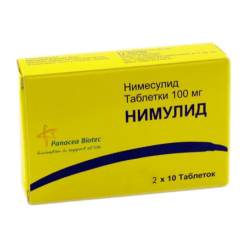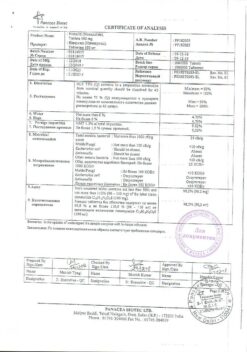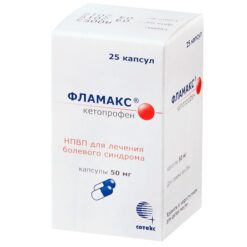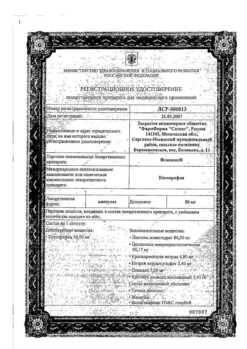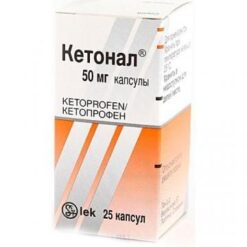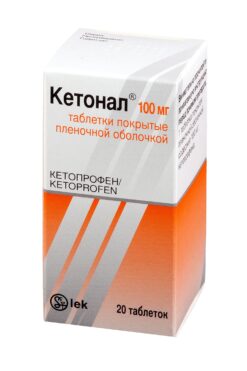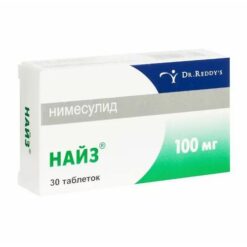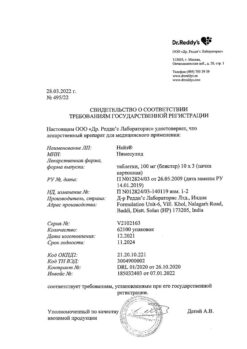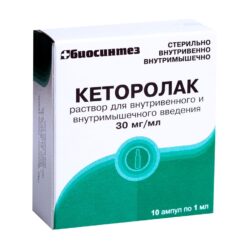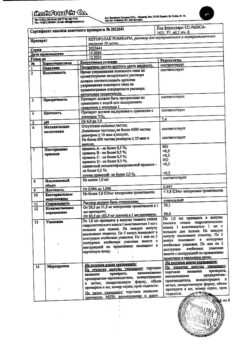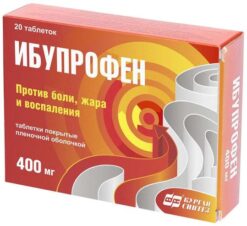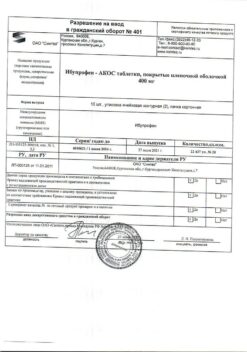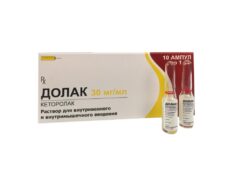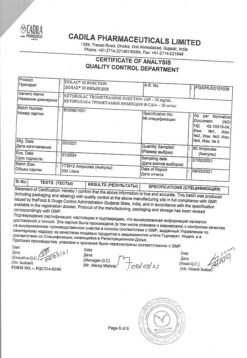No products in the cart.
Nimulide, 10 mg/ml suspension 60 ml
€10.09 €8.83
Description
Clinical and pharmacological group: NSAIDs. Selective COX-2 inhibitor
Pharmacological action
NSAIDs from the class of sulfonanilides, selective competitive reversible COX-2 inhibitor. It has anti-inflammatory, analgesic and antipyretic effect. It has a less pronounced inhibitory effect on COX-1.
Decreases concentration of short-lived prostaglandin H2, a substrate for kinin-stimulated prostaglandin E2 synthesis, in the focus of inflammation and in the ascending pathways of pain impulse conduction in the spinal cord. Reducing the concentration of prostaglandin E2 (mediator of inflammation and pain) reduces the activation of prostanoid receptor EP type, which is manifested by analgesic and anti-inflammatory effects.
Pharmacokinetics
After oral administration, nimesulide is well absorbed from the GI tract, Cmax in plasma is reached after 2-3 h on average and is 3-4 mg/L. AUC is 20-35 mg×h/l. Binding to plasma proteins is 97.5%. After a single oral dose of 100 mg, nimesulide is present in the female genital tissues at a concentration of 40% of the plasma concentration. It is metabolized in the liver with the participation of CYP2C9 isoenzyme. The main metabolite is pharmacologically active parahydroxy derivative of nimesulide – hydroxynimesulide, which is found exclusively as glucuronate. Nimesulide is excreted mainly in the urine (about 50% of the dose taken), about 29% is excreted as metabolites in the feces. T1/2 is 3.2-6 h.
Indications
Indications
Rheumatoid arthritis, osteoarthritis, arthritis of various etiologies, arthralgia, myalgia, postoperative and post-traumatic pain, bursitis, tendinitis, algodismenorrhea, toothache and headache, including fever syndrome.
Pharmacological effect
Pharmacological effect
Pharmacotherapeutic group: non-steroidal anti-inflammatory drug (NSAID).
ATX code: [MO1AX17]
Pharmacological action
Non-steroidal anti-inflammatory drug (NSAID) from the sulfonanilide class. It has the properties of a selective inhibitor of cyclooxygenase-2 (COX-2) – an enzyme involved in the synthesis of prostaglandins – mediators of edema, inflammation and pain; inhibits COX-1 activity to a lesser extent. It has anti-inflammatory, analgesic and antipyretic effects.
Pharmacokinetics
Absorption when taken orally is high. Eating reduces the rate of absorption without affecting its extent. Subject to enterohepatic recirculation. The time to reach the maximum concentration of the active substance in the blood plasma is 1.5-2.5 hours. The connection with plasma proteins is 95%, with erythrocytes 2%, with lipoproteins -1%, with acidic alpha 1-glycoproteins 1%. The dose of the drug does not affect the degree of its binding to blood proteins. The maximum concentration of nimesulide in blood plasma reaches 3.5-6.5 mg/l. Volume of distribution – 0.19 – 0.35 l/kg. Penetrates into the tissues of the female genital organs, where after a single dose its concentration is about 40% of the concentration in plasma. Penetrates well into the acidic environment of the inflammation site (40%) and synovial fluid (43%). Easily penetrates histohematic barriers. Metabolized in the liver by tissue monooxygenases. The main metabolite, 4-hydroxynimesulide (25%), has similar pharmacological activity. The half-life of nimesulide is 1.56 – 4.95 hours, 4-hydroxynimesulide – 2.89-4.78 hours. 4-hydroxynimesulide is excreted by the kidneys (65%) and bile (35%). In patients with renal failure (creatinine clearance 1.8 – 4.8 l/h or 30-80 ml/min), as well as in children and the elderly, the pharmacokinetic profile of nimesulide does not change significantly.
Special instructions
Special instructions
When prescribing the drug to elderly patients, no dosage adjustment is required.
With long-term use, systematic monitoring of liver and kidney function is necessary at least once every two weeks.
If signs of liver damage appear (itching, jaundice, nausea, vomiting, abdominal pain, dark urine, increased activity of liver transaminases), you should immediately stop taking the drug and consult a doctor.
Given reports of visual disturbances in patients taking other non-steroidal anti-inflammatory drugs, if any visual disturbance occurs, treatment should be immediately discontinued and an ophthalmological examination performed.
The drug can cause fluid retention, so nimesulide should be used with extreme caution in patients with high blood pressure and heart disease.
Patients should undergo regular medical monitoring if they, along with nimesulide, take medications that are characterized by an effect on the gastrointestinal tract.
The drug should not be used simultaneously with other non-steroidal anti-inflammatory drugs.
Nimesulide can reduce platelet aggregation, but it does not replace the preventive action of antiplatelet agents (including acetylsalicylic acid, clopidogrel, ticlopidine) in cardiovascular diseases.
The use of the drug may adversely affect female fertility and is not recommended for women planning pregnancy.
Impact on the ability to drive vehicles and machinery
Care must be taken when driving vehicles and engaging in other potentially hazardous activities that require increased concentration and speed of psychomotor reactions.
Active ingredient
Active ingredient
Nimesulide
Composition
Composition
1 ml of suspension contains:
Active ingredient: Nimesulide 10.00 mg;
Excipients:
Xanthan gum 4.00 mg, sorbitol solution 70%, non-crystallized** 100.00 mg, glycerol 30.00 mg, sucrose 200.00 mg, macrogol glyceryl hydroxystearate (Cremophor RH 40) 2.00 mg, sodium methyl parahydroxybenzoate 1.80 mg, sodium propyl parahydroxybenzoate
0.20 mg, sodium benzoate 2.00 mg, colloidal silicon dioxide 2.00 mg, sodium disulfite 0.50 mg, citric acid monohydrate 0.25 mg, hydrochloric acid (concentrated) 0.0014 ml, vanilla flavor 0.00044 ml, mango flavor 0.0008 ml, quinoline yellow dye 0.055 mg, purified water q.s. up to 1 ml.
** – Sorbitol solution 70%, non-crystallized contains: an aqueous solution of hydrogenated partially hydrolyzed starch and water in a ratio of 70:30.
Pregnancy
Pregnancy
Nimesulide is contraindicated for use during pregnancy and breastfeeding.
Contraindications
Contraindications
Hypersensitivity, erosive and ulcerative lesions of the gastrointestinal tract (in the acute phase), bleeding from the gastrointestinal tract, complete or incomplete combination of bronchial asthma, recurrent polyposis of the nose or paranasal sinuses and intolerance to acetylsalicylic acid and other non-steroidal anti-inflammatory drugs (including a history), any abnormal liver function, renal failure (creatinine clearance – less than 30 ml/min), cerebrovascular bleeding, inflammatory bowel diseases (Crohn’s disease, ulcerative colitis) in the acute phase, hemophilia and other bleeding disorders, decompensated chronic heart failure, hepatotoxic
reactions when using nimesulide in history, alcoholism, drug addiction, progressive kidney disease, confirmed hyperkalemia, the period after coronary artery bypass surgery, simultaneous use of other hepatotoxic drugs, pregnancy, lactation, children under 2 years of age.
With caution: arterial hypertension, heart failure, type 2 diabetes mellitus, coronary heart disease, cerebrovascular diseases, dyslipidemia/hyperlipidemia, peripheral arterial disease, smoking, renal failure (creatinine clearance 30-60 ml/min), anamnestic data on the development of ulcerative lesions of the gastrointestinal tract, the presence of Helicobacter pylori infection, elderly age, long-term use of non-steroidal anti-inflammatory drugs, alcoholism, severe somatic diseases, simultaneous use of anticoagulants (including warfarin), antiplatelet agents (including acetylsalicylic acid, clopidogrel), oral glucocorticosteroids, selective inhibitors
serotonin reuptake (including citalopram, fluoxetine, paroxetine, sertraline).
Side Effects
Side Effects
The frequency is classified according to the headings, depending on the occurrence of the case: very often (> 1/10), often (> 1/100), infrequently (> 1/1000), rarely (> 1/10000), very rarely (1/10000).
Central nervous system: infrequently – dizziness; rarely – a feeling of fear, nervousness, “nightmarish dreams”; very rarely – headache, drowsiness, encephalopathy (Reye’s syndrome).
Gastrointestinal tract: often – diarrhea, nausea, vomiting, increased liver transaminases; infrequently – constipation, flatulence, gastritis; very rarely – abdominal pain, stomatitis, tarry stools, gastrointestinal bleeding, ulcer and/or perforation of the stomach or duodenum, hepatitis, fulminant hepatitis, jaundice, cholestasis.
Respiratory organs: infrequently – shortness of breath; very rarely – bronchial asthma, bronchospasm. Cardiovascular system: infrequently – arterial hypertension; rarely – tachycardia, “hot flashes”.
Sense organs: rarely – blurred vision, very rarely – dizziness.
Skin and mucous membranes: infrequently – itching, rash, increased sweating; rarely: erythema, dermatitis; very rarely: urticaria, angioedema, facial swelling, erythema multiforme exudative, incl. Stevens-Johnson syndrome, toxic epidermal necrolysis (Lyell’s syndrome).
Kidneys and urinary system: infrequently – edema; rarely – dysuria, hematuria, urinary retention, hyperkalemia; very rarely – renal failure, oliguria, interstitial nephritis.
Hematopoietic organs: rarely – anemia, eosinophilia; very rarely – thrombocytopenia, pancytopenia, hemorrhage, purpura, prolongation of bleeding time.
Allergic reactions: rarely – hypersensitivity reactions; very rarely – anaphylactoid reactions.
Other: rarely – general weakness; very rarely – hypothermia.
Interaction
Interaction
The effect of medications that reduce blood clotting is enhanced when used simultaneously with nimesulide.
Nimesulide may reduce the effect of furosemide. Nimesulide may increase the possibility of side effects while taking methotrexate. Plasma lithium levels increase when lithium and nimesulide are taken simultaneously.
Due to the high degree of binding of nimesulide to plasma proteins, patients who are simultaneously treated with hydantoin and sulfonamides should be under medical supervision, undergoing examinations at short intervals.
Nimesulide may enhance the effect of cyclosporine on the kidneys.
Hepatotoxic drugs – increase the risk of developing hepatotoxic effects. When used simultaneously with glucocorticosteroids and selective serotonin reuptake inhibitors, the risk of bleeding from the gastrointestinal tract increases.
Overdose
Overdose
Symptoms: apathy, drowsiness, nausea, vomiting. Symptoms are reversible with supportive care. Gastrointestinal bleeding, arterial hypertension, acute renal failure, and respiratory depression may occur.
Treatment: The patient requires symptomatic treatment and supportive care. There is no specific antidote. If an overdose occurs within the last 4 hours, it is necessary to induce vomiting, take activated carbon (60-100 g per adult), and osmotic laxatives. Forced diuresis and hemodialysis are ineffective due to the high binding of the drug to proteins.
Storage conditions
Storage conditions
In a place protected from light, at a temperature not exceeding 25 ° C.
Keep out of the reach of children.
Shelf life
Shelf life
3 years.
Do not use the drug after the expiration date indicated on the package.
Manufacturer
Manufacturer
Panacea Biotech, India
Additional information
| Shelf life | See on the package. |
|---|---|
| Conditions of storage | List B.: In a dry, light-protected place at 15-25 °C. |
| Manufacturer | Panacea Biotec, India |
| Medication form | oral suspension |
| Brand | Panacea Biotec |
Other forms…
Related products
Buy Nimulide, 10 mg/ml suspension 60 ml with delivery to USA, UK, Europe and over 120 other countries.

